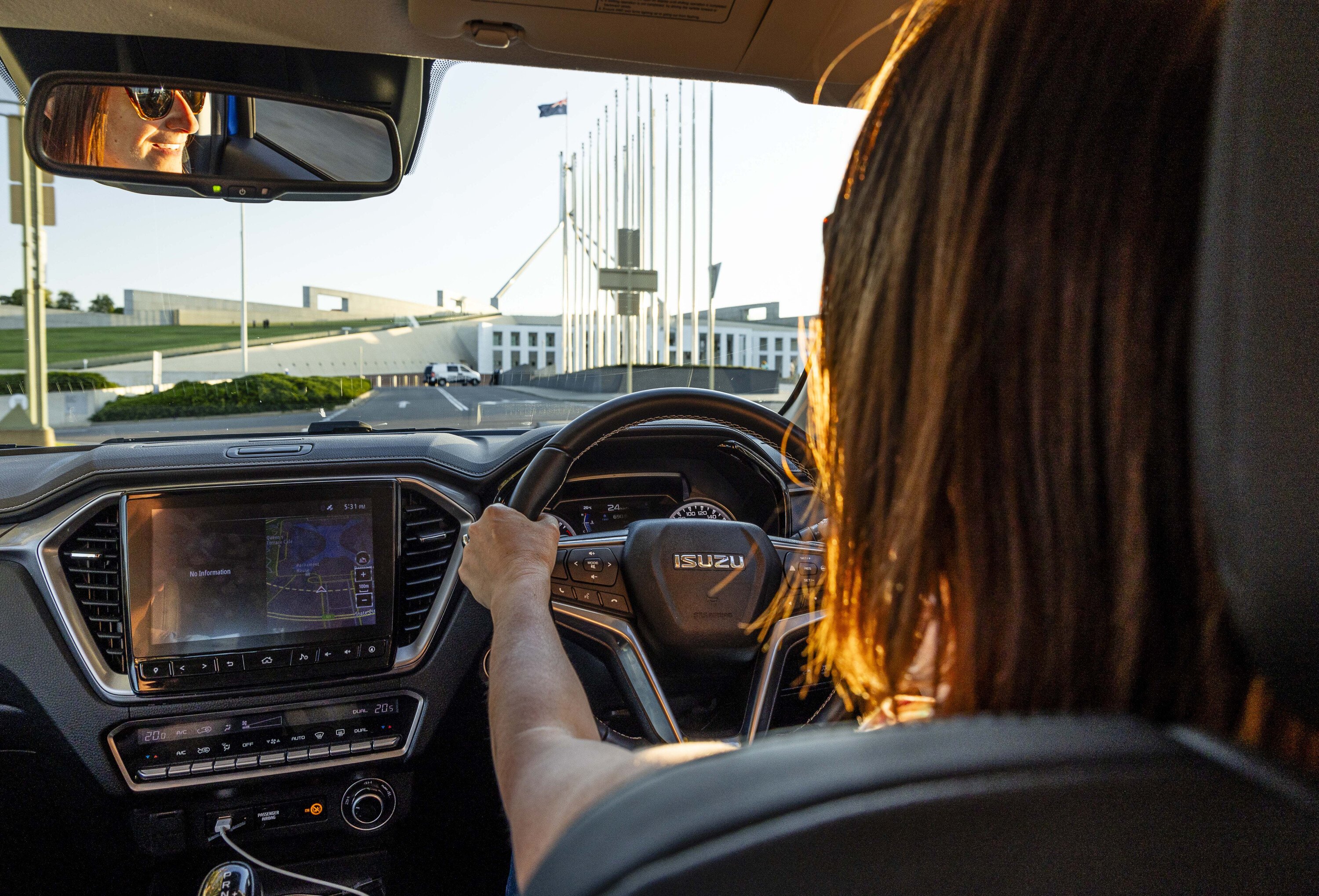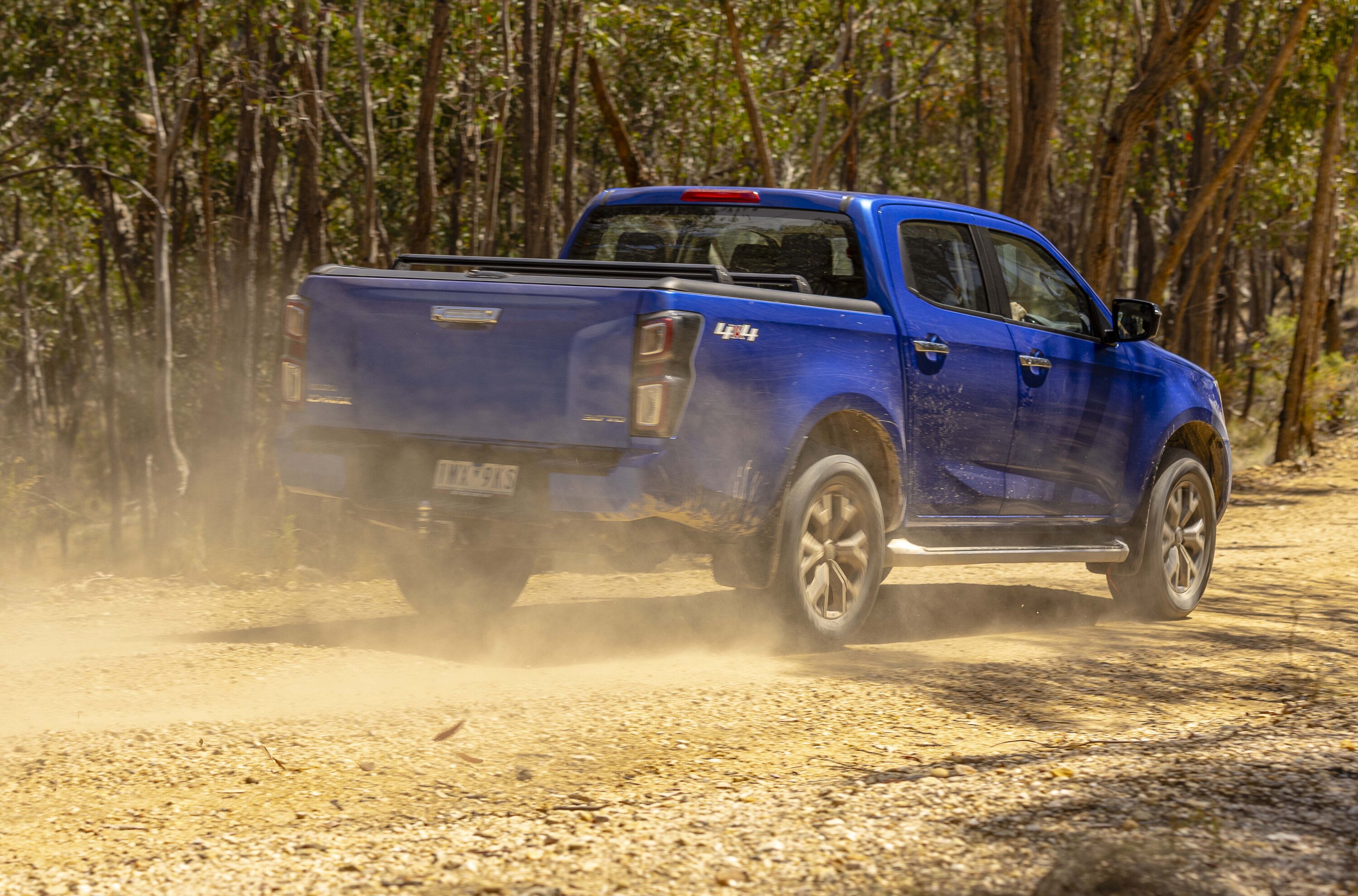
Being an automotive photographer of 26 years, I’ve seen a car or two – capturing images of vehicles driven back and forth by my journo colleagues, snapping them in motion and in all conditions, crawling through their interiors to record the details and accessories.
But, while I’ve been up-close with just about every car on the market, the job of assessing one and putting my impressions into words is an all-together new experience.


Thrown the keys to one of our top-scoring utes, I wondered: what better way to really get to know any car than a big long road trip?
Putting some kays on the ‘odo’ and driving through a variety of conditions should give me a clue or two. So, I decided to head north to warmer waters and sunshine for a short break.
The car
2024 Isuzu D-Max LS-U+ in Neptune Blue
Price
$63,500 before on-road costs – not including the…
Optional extras fitted
- Tow Bar Tongue – $215.05
- 12-Pin Plug – $393.25
- Electronic Brake Controller – $896.05
- Manual Roller Tonneau – $3099
- Cargo Carriers – $545.93
- Rubber Mats – $208.67
- Premium Paint – $650
As tested
All up, we’re looking at $74,336 before on-road costs.

JUMP AHEAD
- First impressions
- Comfort
- Technology / Entertainment
- On the road/drive
- Safety features
- Fuel economy
- Parking
- Last thoughts/impressions
First impressions
At first glance, the D-Max feels smaller than my Toyota FJ, both in looks and my sense behind the wheel.
I love the premium paint in bright blue: it’s a nice change from the grey and white tones that seem the standard for most utes.

Before heading off, there’s the inevitable Tetris packing session. Having the ute, I figure, hey, what the hell, I’ll take everything!
The D-Max tray gives me freedom to throw in the inflatable paddle board and a swag for overnight stops, along with a culmination of camera gear, camping and beach accessories.
Straight away I noticed how convenient it is to have all that space, and particularly the added security of the optional lockable manual roller tonneau.

Comfort
At the wheel, the D-Max’s seating, and especially the lumbar support for my tiny frame, is comfortable.
Steering and all-round adjustment is great, but because I’m a shorty (legs particularly) at 5ft 2in or 157cm, I find it difficult in a lot of cars to achieve a comfortable seating position without having my chin on the steering wheel.
Thankfully, in this case, the options allow for excellent reach to the pedals, great steering wheel adjustment, and an overall good position for my initial long trek up the Hume.

I find all the D-Max’s controls are logically placed, and I quickly locate my favourite: the heated seats, great for early morning starts on the road.
During my break, I caught up with some friends and ended up at one point with three adults in the rear. These utes are big things, but it was nonetheless a bit of a squeeze back there.
Still, while I don’t have children myself, I’m confident two adults or two children would be comfortable in the rear, with good headroom and reasonable space for legs.

Technology & infotainment
The 9.0-inch main display of the LS-U and LS-U+ trim grades, while smaller than some in this increasingly screen-mad age, is amply sized for reading maps. The on-screen controls are all self-explanatory and intuitive, too.
Apple Carplay and Android Auto are both standard, and setting up Carplay in my case was simple (Stevo diving in here to confirm Android Auto is likewise a cinch).

The quirks of modern infotainment…
Alas, without a wireless charging pad on-board for the long drive, I chose to use the USB connection over wireless. An odd combination, really. (Also, Android users should note they’re stuck with wired only.)
Changing to radio while using CarPlay wasn’t simple, but most folk use their apps for podcasts and music these days. I guess I’m old-school and enjoy surfing the local stations. (Stevo’s note: tap the Isuzu icon in CarPlay to return to the native infotainment, and then hop into the media screen to select radio.)

Driving the D-Max LS-U+
Commencing the rather dull Hume Hwy mission through Holbrook and then Gundagai into Canberra before continuing on to Wollongong, I found the adaptive cruise control so advanced beyond my 2016 FJ Cruiser!
It was great adjusting smoothly on both hill climbs and declines, along with steady speed changes when following traffic.
As expected, the D-Max was smooth driving on the highway, but the ride in any ute is of course quite different to your standard sedan or family-oriented 4×4 wagon. Without any load, it’s somewhat bouncy over bumps, potholes and speed humps. The steering is light and responsive, at least, and especially when compared to my FJ.

Off-road, on gravel, I needed to drive smart – knowing that it could slip on corrugated corners at speed again due to the lack of rear load.
Adjusting the terrain command dial simply, I had a play over light articulation and muddy holes. I found it was very capable in every aspect, and knowing it could excel on greater challenges that I’d be keen to try down the track.
The D-Max’s powerful 140kW/450Nm 3.0-litre turbo diesel engine presents a marked change from my 200kW/380Nm 4.0-litre V6. And, whilst it rumbles, it has excellent take off and acceleration – along with a towing capacity rated at 3.5 tonnes.

Safety features
Like all new cars with their increasingly long lists of safety features, the D-Max is equipped with IDAS (intelligent driver assist system) and a top-shelf 5 star ANCAP rating.
The driver assist system feels like a great innovation in concept – but, while it’s designed to be helpful, it can be alarming on a long trip and it’s somewhat over sensitive to lane positioning.
Also, I experienced several instances where the AEB (autonomous emergency braking) activated even after I already had my foot gently pushing on the brakes to slow down.

Still, emergency braking is a great feature to have and I’m sure it has stopped many low-speed bingles or those accidental rolling incidents we all want to avoid. For the most part, the safety tech does keep you alert.
I must admit, though, that I found the walk-away door locking system a little too sensitive, locking not even two metres from the car – so forgetting something and wanting to quickly re-open the door was a comedic affair.
Of course, for those who choose it, you can deactivate many of these features.

Fuel economy
The turbo-diesel engine balanced power with great fuel efficiency on my trip.
Overall, I averaged 7.8L/100km with a variety of on and off road driving conditions – requiring only two refills for a two-week round trip of around 2500km.

Parking
Already owning an older 4×4 of my own, I found this new D-Max a pleasure to park (as much as one can take pleasure in such things), with effective camera vision through the screen and reliable sensor alerts.

Last thoughts
All in all, I really enjoyed the D-Max. It’s user friendly, comfortable inside and was perfect for my road trip.
Excellent efficiency, huge capability and useful for all my adventures, even coming in useful with an unexpected load of bread we delivered to a charity group in Canberra.
A note for those carrying expensive cargo, though: while the tonneau was lockable, I found the dual-locking process frustrating. Not only do you have to hand-lock the tray-back (which doesn’t auto lock), but it also uses a separate key to the tonneau cover.
Overall, the D-Max is a fantastic package for those looking for an everyday-driver dual-cab that excels for those adventuring types who want to load the toys in the back and get out of town, or just exercise their DIY work at home.




